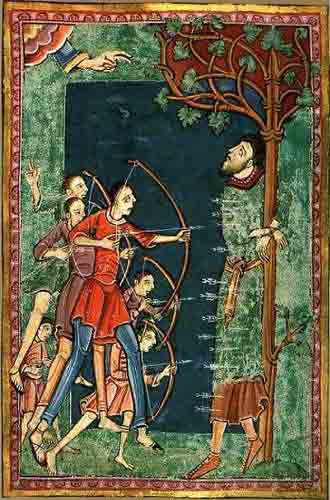The holy
and right-believing King Edmund the Martyr was a king
and martyr of East Anglia in the ninth century. He succeeded
to the throne of East Anglia in 855 as a fourteen year old.
He died a martyrís death battling the ďGreat Heathen ArmyĒ,
a large army of Vikings that pillaged and conquered much of
England in the late ninth century. He was venerated early
and became popular among the Anglo-Norman nobility. His
feast day is November 20.
Edmund was
born in 841. Early accounts and stories provide a cloud over
who is his father. The sources considered the most reliable
represent Edmund as descended from the preceding kings of
East Anglia. When King Ethelweard died in 854, it was
Edmund, while only fourteen years old, who succeeded to the
throne.
Little is
known of Edmundís next fourteen years. His reign was said to
be that of a model king. He was said to have treated all
with equal justice and was unbending to flatterers. He was
said to have spend a year at his residence at Hunstanton
learning the Psalter which he was able to recite from
memory.
The
sources' description of his martyrdom vary. The Danes of the
Great Heathen Army advanced on East Anglia in 869 and were
confronted by King Edmund and his army. While Edmund may
have been killed in battle, popular traditions are that
Edmund refused the heathen Danesí demands that he renounce
Christ or that he could hold his kingdom as a vassal under
heathen overlords. Both stories date from soon after his
death and it is not known which may be correct.
According
to an early biographer, Abbo of Fleury, Edmund chose, in the
manner of Christ, not to strike arms with the heathen Danes
and was captured and taken to Hoxne in Suffolk. There he was
beaten and then tied to a stout tree where he was again
beaten. Hearing Edmundís calls to Christ for courage, the
Danes further attacked him, shooting many arrows into the
bound king who showed no desire to renounce Christ. Finally,
he was beheaded on November 20, 869.

Edmundís
body was interred at Beadoriceworth, the modern Bury St
Edmunds. This place became a shrine of Edmund that greatly
increased his fame. His popularity among the nobility of
England grew and lasted. His banner became a symbol among
the Anglo-Normans in their expeditions to Ireland and to
Caerlaverock Castle. His crest was borne on a banner at the
Battle of Agincourt. Churches and colleges throughout
England have been named after St Edmund.
In recent
years, moves were made in England to restore St Edmund as
the patron saint of England. Edmund had been replaced by St
George as the patron saint through King Edward IIIís
association of St George with the Order of the Garter. The
attempt failed. However, St Edmund was named the patron
saint of the County of Suffolk in 2006.

